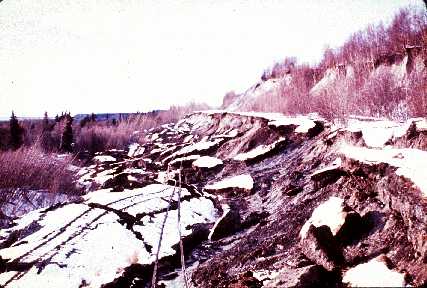

Anchorage, Alaska. March 27, 1964, 5:36 p.m. Fourth Avenue. One of the largest earthquakes ever recorded hits Southcentral Alaska. People scream in horror as cars hopskotch across the street, windows explode outward and walls collapse. A car disappears under the ground, gas and water lines burst with a hiss and people grab parking meters or light poles to keep their balance. Some people thought the Russians were attacking.
Since the railroad's communication system was
virtually wiped out, the only damage assessment that could be made before
darkness set in was by the headquarters staff in the immediate area of
the Anchorage Terminal. "Our terminal yard and headquarter facilities here
in Anchorage received their share of damage: the office annex building,
wheel shop and an equipment storage building were heavily damaged and had
to be razed. The large car repair shop received heavy structural damage
to the roof system and required extensive repairs and the poor old Army
Dock, which dated back to original construction and unused for many years,
finally succumbed to earthquake damage." [5]
 Photo from the Earth Science Photographs from the U.S. Geological Survey Library |
"A series of earthquake triggered landslides in glacial deposits disrupted almost a mile of The Alaska Railroad main line at Potter Hill, near Anchorage." [1] |
| "Collapse of Fourth Avenue near C Street, Anchorage, due to earthquake caused landslide. Before the earthquake, the sidewalk at left, which is in the graben, was at street level on the right. The graben subsides 11 feet in response to 14 feet of horizontal movement. Anchorage district, Cook Inlet region, Alaska. 1964." [1] |
 Photo from the Earth Science Photographs from the U.S. Geological Survey Library |
earthquake main | earthquake
story | information credits |
ARR
main page
The information on this page was last updated November 24, 1998